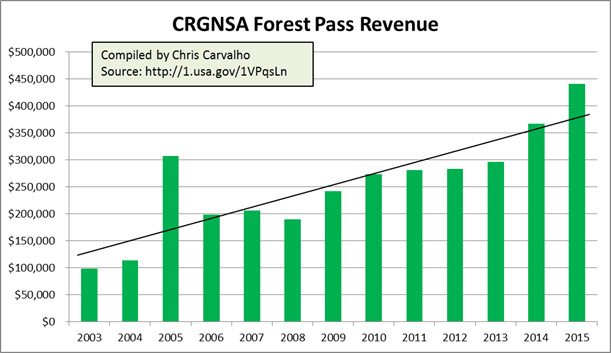







This is the full version of the article. Click here to return to the blog's home page.
Forest Service Hoards $14 Million from Recreation Fees; Trails Suffer
An Embarrassment of Riches, Poverty of Programs
Entry 17: October 2, 2016.
| Hikers in the Columbia River Gorge National Scenic Area (CRGNSA) are familiar with the Northwest Forest Pass, a $30 annual permit required at many sites on federal land. The fee program operates in Washington and Oregon, with collections allocated to participating regional forests. Revenues in the Scenic Area have climbed steadily from $100,000 in 2003 to $441,000 in 2015, a 7% annual growth trend. | 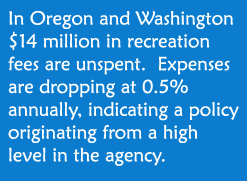 |
|
|
|
The Forest Service posts annual reports of revenues and projects completed at this link. Each year, it spends a portion of the revenue on projects that include labor, materials, repairs, trail maintenance, and construction. Unspent funds are accounted as "carryover" and used for the following year's startup costs. The carryover isn't reported, but is easily calculated and shown below:
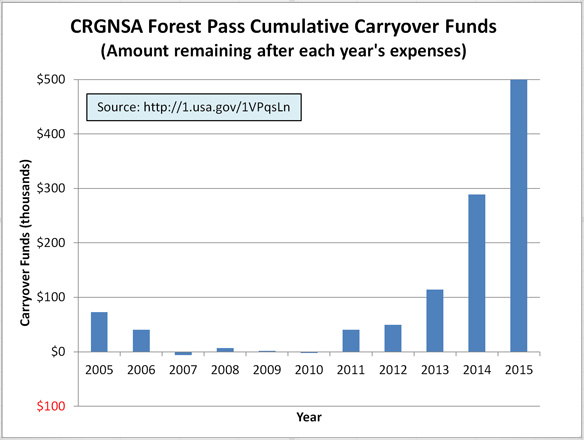
Starting in 2013, carryover amounts increased dramatically. Today, they total $499,783. Expenses are declining, however. Spending on projects in 2015 was the third lowest in the past ten years. Adjusted for inflation, spending is decreasing at a negative 1.6 percent annual rate:
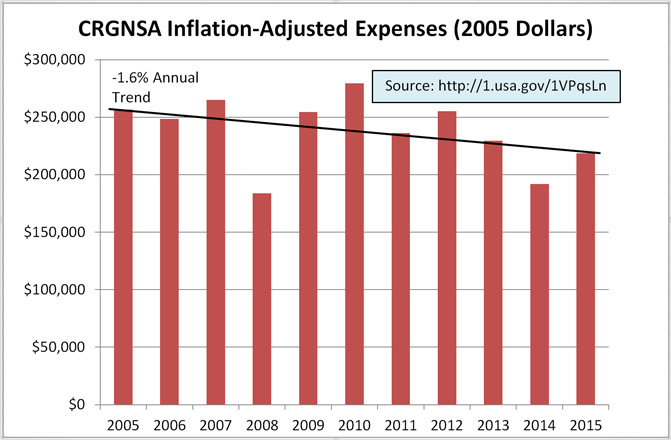
I thought such a large carryover might be an accounting error or an omitted expense in the reports, so I contacted Stan Hinatsu, recreation programs manager for the CRGNSA. He verified the carryover is correct. It seems unusual that while revenue and carryover are growing, spending on recreation projects is dropping. This explains the increasing backlog of damaged and obstructed trails and no new trail construction, despite 2016 being a year with widely acknowledged overcrowding on trails in the gorge. He indicated that $350,000 in planned work is expected for fiscal year 2016. He said that according to law, any projects must have cash in hand before incurring expenses but didn't know the specific law requiring this.
Why is the Forest Service hoarding fee dollars? We will only know after a top-level official agrees to speak on the record about it, or a freedom of information request finds the root cause. A lawsuit by recreation interest groups could also free up the funds. We know the agency faces monumental costs for firefighting after years of misguided fire suppression. It could be tapping fee money to defray those costs, or using it as collateral for a loan to pay off the fire costs until it can find another source of funds. Hinatsu mentioned that regional management places a "limitation" each year on how much the district can spend out of collections. Fees are classified as a trust account so any money taken out must be returned. However, there's no deadline on returning borrowed fees. This situation isn't unique to the CRGNSA; it's much bigger. Here's the real story: In Oregon and Washington overall, current carryover is $14 million with 2015 revenue of $11 million and expenses are dropping at 0.5 percent annually, indicating a policy originating from a high level in the agency.
Below are three charts showing the consolidated Forest Pass data for Oregon and Washington. Both the CRGNSA and the entire region have two years of spending squirreled away in carryover. When will this money be released?
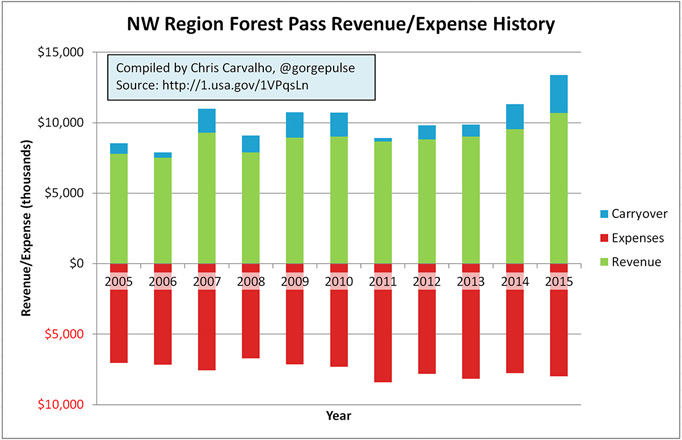
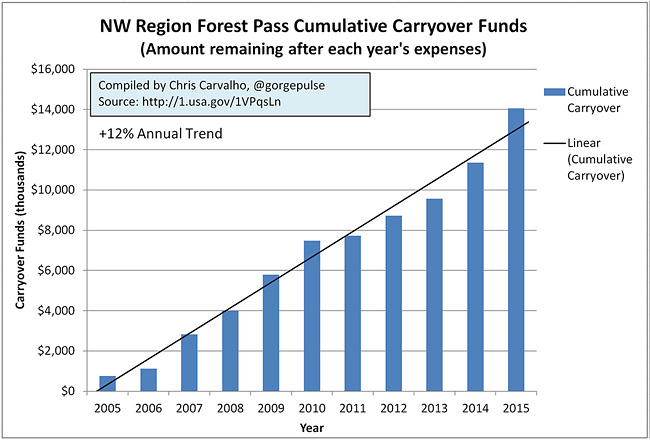
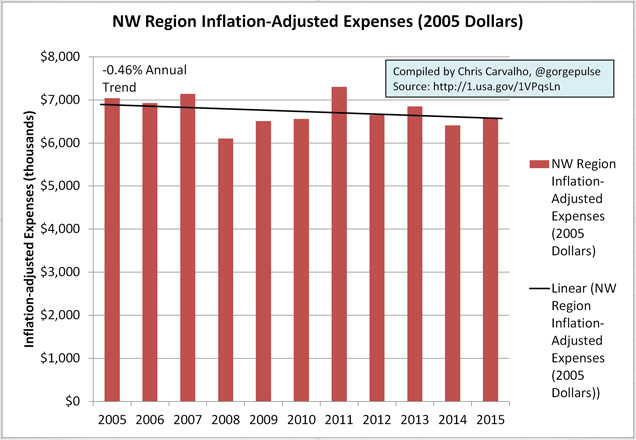
There are four reforms that would make a big difference in the level of service to recreation users. First, fee dollars should be sequestered so that they can't be diverted for non-recreation spending. Second, the Forest Service's policy requiring up-front cash before spending on projects slows its ability to respond to unpredictable events, such as a bad winter that causes lots of blowdown on trails. Any bank would be more than happy to lend to a business with a guaranteed source of growing cash flow, as the fee dollars are. It's time to allow use of short-term loans when they make sense. Third, spending priorities need improved oversight. Hinatsu said that today, staff makes spending decisions from their experience on the ground plus public input from letters, email, and phone calls. There should be a more structured process with open meetings where the public can help prioritize projects so funds are spent for the benefit of the greatest number of users. He mentioned some of the banked dollars will be spent on a rather expensive project to create a portage at BZ Corner, Washington, for rafting the White Salmon River. Outfitters will pay some of the cost, but this project will benefit a small number of users that perhaps should pay a larger share considering other glaring needs such as restricted parking at Dog Mountain, a trail closure at Eagle Creek, and many miles of trail obstructed by blowdown. Fourth, cumulative carryover should be limited and reported so hoarding is obvious.
Letting fee dollars sit in the bank, assuming they are still there, not only stiffs the recreation community but it creates a drag on the local economy. Fourteen million dollars could create 270 family-wage jobs, and those people could make a noticeable difference in the trail systems of Oregon and Washington. Keeping the money locked up risks losing the public's trust for the Forest Service to responsibly use future fee increases to provide better services. The sooner this money gets to our struggling trail system, the better.
Chris Carvalho has a Bachelor of Science degree in chemical engineering from the University of California at Berkeley. He is a photographer and blogger on public policy, environmental, and conservation topics.
